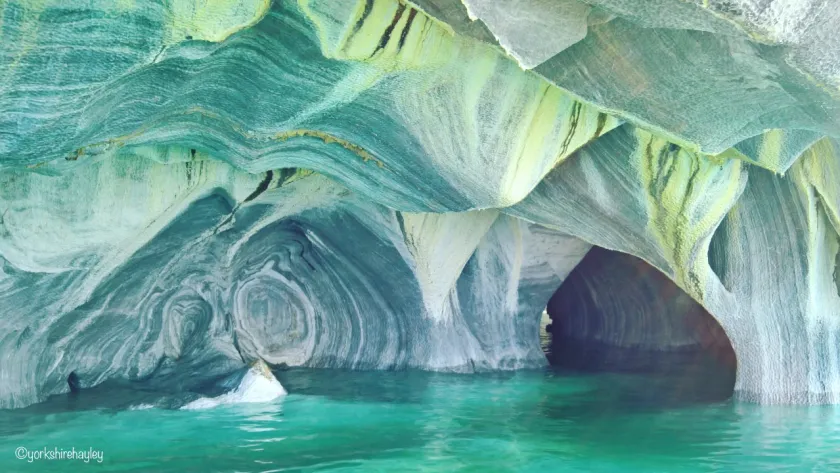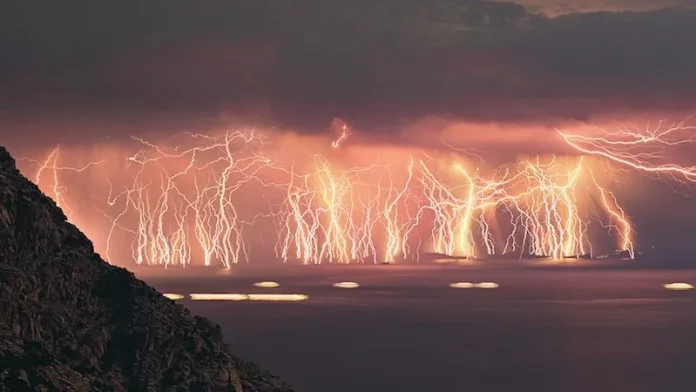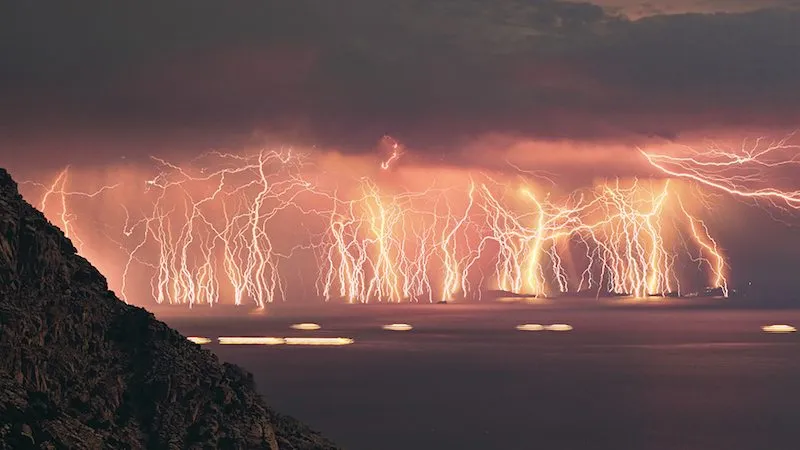The Marble Caves, located in the heart of Chilean Patagonia, are a breathtaking natural wonder that attracts visitors from around the globe. Known locally as “Cuevas de Mármol,” these caves are nestled within the General Carrera Lake, one of South America’s largest and most pristine freshwater lakes. The Marble Caves, Chile’s hidden gem, offer a visual spectacle that seems almost otherworldly.
Formed over 6,000 years, the Marble Caves are made of solid marble that has been gradually sculpted by the azure waters of the lake. The constant ebb and flow of the water have carved out intricate, swirling patterns in the marble, creating a kaleidoscope of blues, greens, and whites. This mesmerizing dance of colors changes with the seasons and the time of day, making each visit a unique experience.
Discovered in the 19th century, the Marble Caves quickly became a subject of fascination for geologists and adventurers alike. The caves are part of the larger marble formations known as the Marble Cathedral and the Marble Chapel, which also feature stunning natural architecture. These formations are accessible only by boat, adding to the sense of adventure and mystery surrounding them.
For a similar wonder of nature, explore the Galapagos Islands, renowned for their unique ecosystems and volcanic landscapes. The Marble Caves in Chile are not just a feast for the eyes; they also hold significant geological importance. The marble, originally limestone, was transformed over millennia by heat and pressure, resulting in the spectacular formations we see today. This process offers a glimpse into the dynamic and powerful forces of nature at work.
The Marble Caves in Chile are not just a feast for the eyes; they also hold significant geological importance. The marble, originally limestone, was transformed over millennia by heat and pressure, resulting in the spectacular formations we see today. This process offers a glimpse into the dynamic and powerful forces of nature at work.
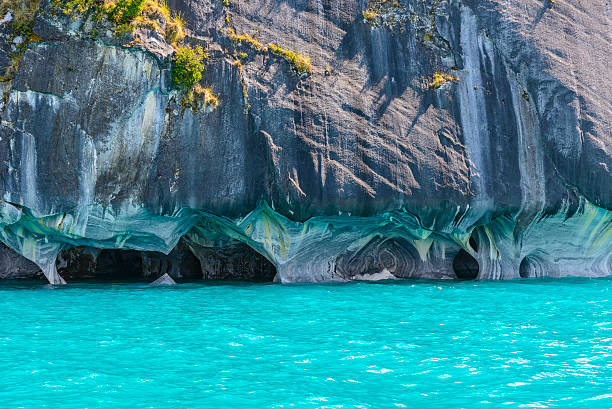
Visitors to the Marble Caves can explore the intricate passages and chambers by kayak or small boat. The best time to visit is between September and February when the weather is favorable, and the light conditions enhance the caves’ natural beauty. Each tour provides an opportunity to witness the stunning interplay of light and water, making the Marble Caves a must-see destination for nature enthusiasts.
In summary, the Marble Caves of Chile are a natural wonder that captivates with their beauty and mystery. Their unique formation, vibrant colors, and remote location make them a truly remarkable sight, underscoring the incredible power and artistry of nature.
The Geological Marvel: What Type of Rock are the Marble Caves Made Of?
The Marble Caves in Chile are a geological marvel, primarily composed of marble, a metamorphic rock that originates from limestone. Over millions of years, the limestone was subjected to intense heat and pressure beneath the Earth’s crust, transforming it into marble. This metamorphic process is what gives the Marble Caves their stunning, smooth appearance and intricate patterns.
The formation of marble begins with the accumulation of marine sediments, primarily calcium carbonate, at the bottom of ancient seas. These sediments gradually compact and cement together to form limestone. As tectonic movements push the limestone deeper into the Earth’s crust, it encounters high temperatures and pressures, causing it to recrystallize and form marble. This process not only changes the rock’s structure but also often introduces a variety of minerals, which can create the beautiful veins and color variations seen in the marble.
The Marble Caves in Chile display a mesmerizing array of colors, including blues, greens, and whites. These colors result from the mineral impurities present in the marble. For example, the blue hues are due to the presence of copper, while the greens can be attributed to serpentine. The unique swirling patterns within the caves are a result of the marble being sculpted over thousands of years by the erosive action of water from General Carrera Lake.
The discovery of the Marble Caves dates back to the 19th century, capturing the attention of geologists and explorers. Their significance lies not just in their beauty, but in the insights they provide into geological processes. The marble in these caves offers a tangible connection to Earth’s dynamic history, illustrating the powerful natural forces that shape our planet.
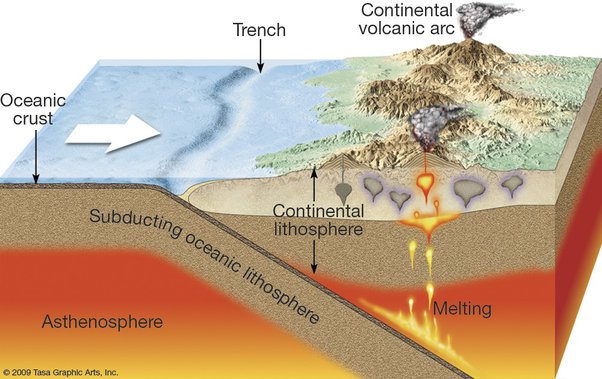
Today, the Marble Caves are a protected natural monument, attracting thousands of visitors each year. The caves are accessible only by boat, ensuring that their delicate formations remain preserved. Kayaking through the Marble Caves allows visitors to witness firsthand the incredible textures and colors of the marble, making it an unforgettable experience.
The Marble Caves of Chile are composed of marble, a rock that has undergone a remarkable transformation from limestone. This geological marvel not only showcases the beauty of nature’s artistry but also highlights the powerful forces at work beneath the Earth’s surface. The Marble Caves remain a testament to the enduring wonder of our planet’s geological history.
Historical Context: The Discovery and Early Exploration of the Marble Caves
The Marble Caves, located in Chile’s remote Patagonia region, have a fascinating history that dates back to their discovery in the late 19th century. These captivating caves, known for their stunning marble formations, were first brought to global attention through the efforts of early explorers who ventured into the rugged wilderness of Patagonia.
The Marble Caves were discovered by local Chilean settlers in the 1890s. These settlers were primarily involved in cattle ranching and, while exploring the vast expanses of the Patagonian landscape, they stumbled upon the remarkable marble formations along the shores of General Carrera Lake. The settlers were amazed by the intricate patterns and vibrant colors of the caves, which had been carved by the lake’s waters over thousands of years.
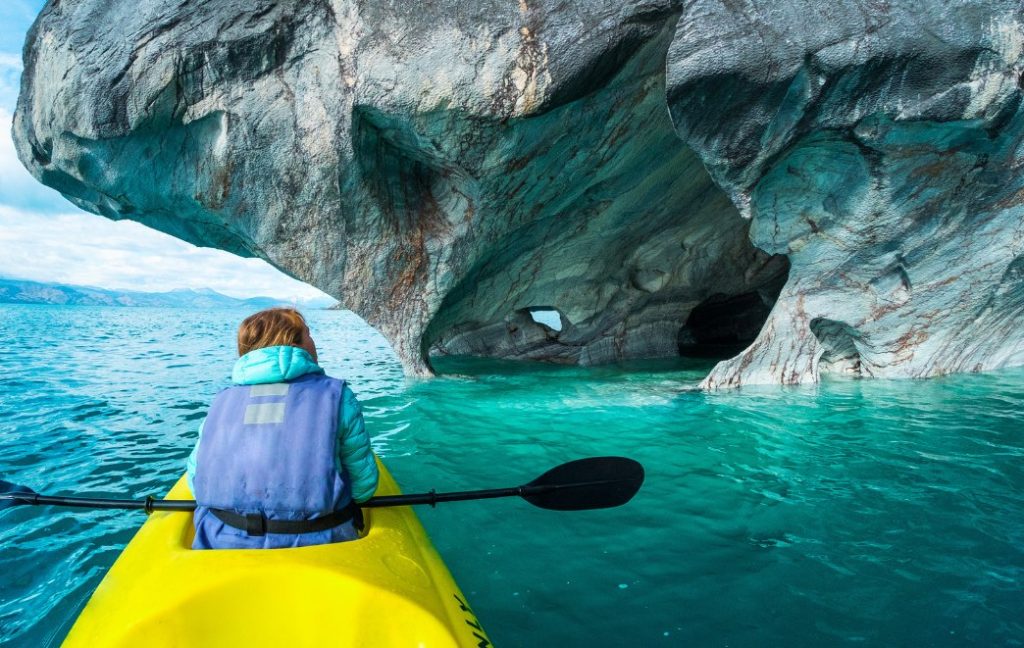
The early 20th century saw increased interest in the Marble Caves as word of their beauty spread. Geologists and naturalists from around the world were drawn to Patagonia to study these unique geological formations. One of the most notable early explorers was a Chilean geologist, who conducted detailed surveys and documented the caves’ structure and composition. His work laid the foundation for understanding the geological processes that formed the Marble Caves.
In the 1960s and 1970s, advancements in transportation and infrastructure made the Marble Caves more accessible to both scientists and tourists. This period marked the beginning of organized tours, allowing visitors to experience the caves’ beauty firsthand. Small boats and kayaks became popular means of exploring the caves, providing an up-close view of the marble walls and the stunning reflections on the water.
The Marble Caves continued to gain international recognition throughout the late 20th century. Travel writers and photographers from around the globe visited the site, sharing their experiences and captivating images with a broader audience. This increased exposure helped to cement the Marble Caves as one of Chile’s most cherished natural attractions.
Today, the Marble Caves are protected as part of a national monument, ensuring their preservation for future generations. The historical journey from their discovery by local settlers to their status as a renowned natural wonder highlights the enduring allure and significance of the Marble Caves. These caves not only offer a glimpse into the geological history of Patagonia but also stand as a testament to the explorers and scientists who brought their beauty to the world’s attention.
Formation of the Marble Caves: Natural Processes Over Millennia
The formation of the Marble Caves, located in Chile’s stunning Patagonia region, is a testament to the powerful natural processes that shape our planet. These mesmerizing caves, situated on General Carrera Lake, have been sculpted over thousands of years through a combination of geological and hydrological forces.
The story of the Marble Caves begins with the formation of marble itself. Marble originates from limestone, a sedimentary rock composed mainly of calcium carbonate. Millions of years ago, the area that is now Patagonia was covered by ancient seas, where marine organisms accumulated on the sea floor, forming thick layers of limestone. Over time, tectonic movements caused the limestone to be buried deep beneath the Earth’s surface, where it was subjected to intense heat and pressure. This process, known as metamorphism, transformed the limestone into marble, a denser and more crystalline rock.
Once the marble was formed, the next chapter in the creation of the Marble Caves began. General Carrera Lake, the second-largest freshwater lake in South America, played a crucial role in shaping these unique formations. Over the past 6,000 years, the lake’s waters have continuously eroded the marble, carving out intricate caves and tunnels. The water’s constant movement, combined with its mineral content, gradually wore away the marble, creating smooth, swirling patterns and stunning hues of blue, green, and white.
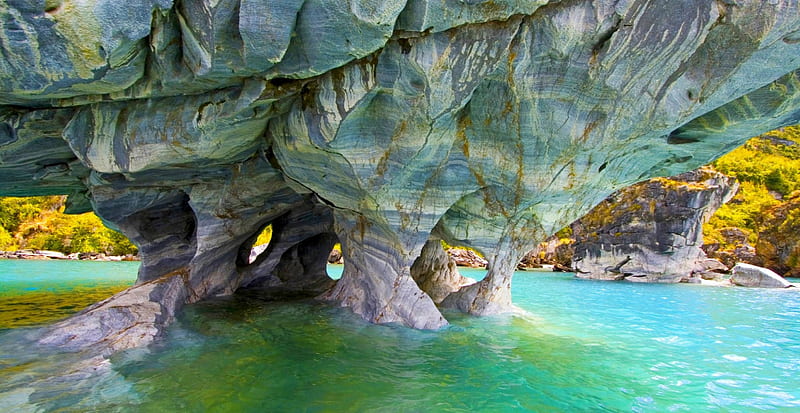
The varying water levels of General Carrera Lake, influenced by seasonal changes and glacial meltwater, further contributed to the caves’ formation. During periods of high water, the lake’s waves would reach deep into the marble, expanding existing caves and creating new passages. When the water levels receded, air and light could penetrate the caves, enhancing their visual beauty and creating the kaleidoscopic effect that visitors marvel at today.
In addition to the lake’s erosive power, the mineral composition of the marble itself played a role in the caves’ appearance. The presence of impurities, such as copper and iron, introduced a variety of colors into the marble. These minerals, combined with the natural white and grey tones of pure marble, resulted in the vibrant and ever-changing palette that characterizes the Marble Caves.
In summary, the Marble Caves of Chile are the result of a fascinating interplay between geological and hydrological processes. From the ancient formation of marble to the relentless sculpting by General Carrera Lake, these natural wonders showcase the incredible power and beauty of nature. The Marble Caves stand as a living testament to the dynamic forces that continue to shape our world, captivating all who have the privilege to witness them.
Visiting the Marble Caves: How to Get to the Marble Caves in Chile
The Marble Caves in Chile, located in the remote region of Patagonia, are a spectacular natural wonder that attracts adventurers from all over the world. Nestled within General Carrera Lake, these stunning formations can only be accessed by boat, making the journey to see them an exciting part of the experience. Here’s a practical guide on how to visit the Marble Caves and make the most of your trip.
Location and How to Get There
The Marble Caves are situated on the western shore of General Carrera Lake, which straddles the border between Chile and Argentina. The nearest town on the Chilean side is Puerto Río Tranquilo, a small but charming village that serves as the main gateway to the caves.
To reach Puerto Río Tranquilo, you will likely need to fly into Balmaceda Airport, the closest major airport. From Balmaceda, it’s about a five-hour drive south along the Carretera Austral, one of the most scenic roads in Chile. The journey offers breathtaking views of Patagonia’s landscapes, including lush forests, snow-capped mountains, and crystal-clear rivers.
Exploring the Marble Caves
Once in Puerto Río Tranquilo, there are several ways to visit the Marble Caves. The most popular and accessible method is by taking a guided boat tour. Numerous local operators offer daily excursions to the caves, usually lasting around two hours. These tours provide an up-close view of the caves’ stunning marble formations and are suitable for all ages.
For those seeking a more immersive experience, kayaking is an excellent option. Several operators rent kayaks and offer guided tours, allowing visitors to navigate through the caves at their own pace. Kayaking provides a unique perspective and the opportunity to explore smaller, hidden sections of the caves that larger boats can’t reach. The best time to kayak is during the morning when the waters are typically calmer.
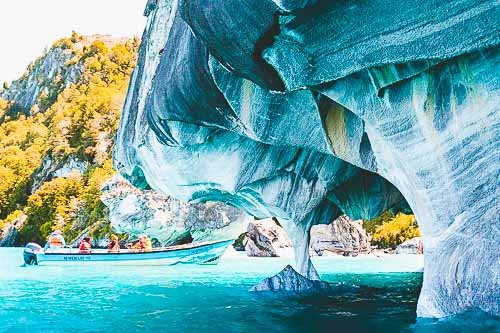
Tips for a Successful Visit
- Timing: The best time to visit the Marble Caves is between November and February when the weather is warmer and the lake’s water levels are ideal for exploring.
- Clothing: Dress in layers and bring waterproof clothing, as weather conditions can change rapidly in Patagonia. Even on sunny days, the lake can be chilly.
- Safety: Always wear a life jacket, whether you’re on a boat or kayak. Listen to your guide’s instructions and stay close to your group, especially if you’re kayaking.
- Photography: Bring a waterproof camera or a good-quality phone case to capture the vibrant colors and stunning formations of the caves.
Visiting the Marble Caves in Chile is an unforgettable adventure that combines the thrill of travel with the awe-inspiring beauty of nature. Whether you choose a boat tour or a kayaking expedition, the journey to the Marble Caves promises to be a highlight of any trip to Patagonia.
The Marble Caves of Patagonia: A Visual and Sensory Experience
Visiting the Marble Caves of Patagonia is a feast for the senses, offering an unforgettable experience that captivates both the eyes and the soul. Located on the shores of General Carrera Lake in Chile, these natural wonders, known as the Marble Caves, are renowned for their breathtaking beauty and unique formations. The journey to the caves is just the beginning of an extraordinary adventure.
As you approach the Marble Caves by boat, the first thing that strikes you is the vibrant blue water of General Carrera Lake, contrasting against the pristine white marble formations. The sunlight dances on the surface of the water, creating a dazzling display of reflections and colors. The lake itself is crystal clear, allowing you to see the intricate patterns and swirls of the marble even from a distance.
Entering the caves, you are immediately enveloped by an otherworldly atmosphere. The marble walls, polished smooth by thousands of years of erosion, shimmer in shades of blue, green, and white. Each twist and turn reveals new patterns and shapes, resembling abstract art created by nature. The colors seem to change with the light, creating a dynamic and ever-shifting visual spectacle.
The sensory experience is not limited to sight alone. As you glide through the caves in a boat or kayak, you can feel the cool, crisp air of Patagonia against your skin. The gentle lapping of the water against the marble walls creates a soothing, rhythmic sound that echoes softly within the caves. This serene environment invites you to slow down and fully immerse yourself in the natural beauty around you.
One of the most enchanting aspects of the Marble Caves is the way they interact with light. During different times of the day and under varying weather conditions, the appearance of the caves can change dramatically. In the early morning, the caves are bathed in soft, diffuse light, highlighting the subtle details of the marble. As the sun rises higher, beams of light penetrate deeper into the caves, illuminating the interiors with a brilliant glow. On cloudy days, the caves take on a more muted, mysterious appearance, adding to their allure.
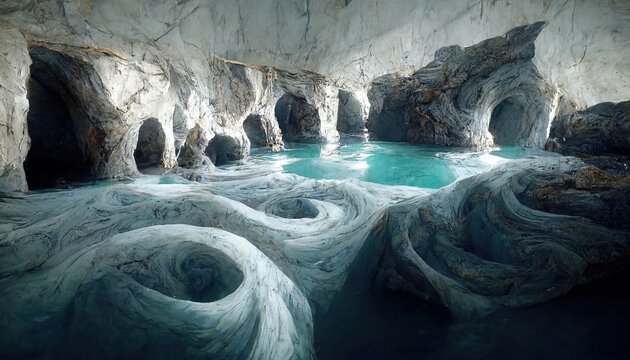
Photographers and nature enthusiasts alike are drawn to the Marble Caves for their unparalleled beauty. Capturing the perfect shot requires patience and an eye for detail, as the light and colors are constantly shifting. Many visitors find themselves spending hours exploring and photographing the caves, eager to capture the ever-changing interplay of light and marble.
In summary, the Marble Caves of Patagonia offer a visual and sensory experience unlike any other. From the stunning colors and patterns of the marble to the tranquil sounds and cool air of the caves, every moment spent here is a reminder of the incredible power and artistry of nature. Whether you are a seasoned traveler or a first-time visitor, the Marble Caves are sure to leave a lasting impression, inviting you to return and experience their beauty anew.
The Enduring Allure of the Marble Caves in Chile
The Marble Caves in Chile have captivated the hearts and minds of explorers, geologists, and tourists for over a century. Their enduring allure lies in the combination of natural beauty, geological significance, and the sense of adventure they invoke. As one of Patagonia’s most cherished natural wonders, the Marble Caves continue to inspire awe and fascination.
Located in the pristine waters of General Carrera Lake, the Marble Caves offer a visual spectacle that is unparalleled. The caves, formed over 6,000 years by the erosive action of water against marble, display a stunning array of colors and patterns. These natural formations, with their swirling blues, greens, and whites, change with the light and seasons, ensuring that no two visits are ever the same.
The geological marvel of the Marble Caves begins with limestone, which over millions of years, transformed into marble through intense heat and pressure. The continual flow of lake water then carved out intricate passages and chambers within the marble, creating the otherworldly formations we see today. This dynamic process highlights the incredible forces of nature and offers a tangible connection to the Earth’s history.
Visiting the Marble Caves is an immersive sensory experience. The journey to the caves, often by boat or kayak, provides breathtaking views of Patagonia’s landscapes. Once inside the caves, visitors are surrounded by the cool, crisp air and the soothing sound of water lapping against the marble walls. The interplay of light and color within the caves adds to the magical atmosphere, making each visit unique and memorable.
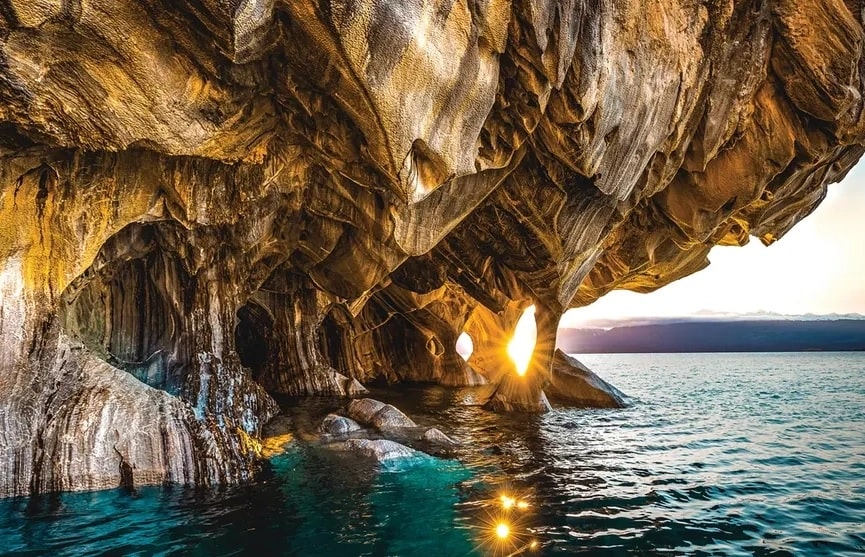
The Marble Caves are not only a feast for the eyes but also a significant geological site that continues to attract researchers and scientists. The caves provide valuable insights into the processes of metamorphism and erosion, contributing to our understanding of Earth’s dynamic systems.
The ongoing fascination with the Marble Caves can be attributed to their natural beauty, accessibility, and the sense of wonder they inspire. The caves have become a must-see destination for travelers seeking to experience the raw beauty of nature. Whether you are a seasoned adventurer or a casual tourist, the Marble Caves in Chile offer an unforgettable journey into one of the world’s most remarkable natural phenomena.
In conclusion, the Marble Caves in Chile stand as a testament to the enduring allure of nature’s artistry. Their unique formations, vibrant colors, and the serene environment they offer continue to draw visitors from around the globe. For those who seek to witness one of nature’s most captivating creations, the Marble Caves are an essential destination. Encouraging readers to explore these natural wonders, one can only anticipate the continued admiration and study of the Marble Caves for generations to come.
Frequently Asked Questions (FAQs)
1. Where are the Marble Caves located?
The Marble Caves are located on the western shore of General Carrera Lake in Chile, near the town of Puerto Río Tranquilo.
2. How were the Marble Caves formed?
The Marble Caves were formed over thousands of years by the erosive action of General Carrera Lake’s water on the marble rock formations.
3. Can you swim in the Marble Caves?
No, swimming inside the Marble Caves is not allowed due to safety concerns and to preserve the delicate formations.
4. What activities can you do at the Marble Caves?
Visitors can explore the Marble Caves by boat or kayak, enjoying guided tours that offer close-up views of the stunning marble formations.
5. When is the best time to visit the Marble Caves?
The best time to visit the Marble Caves is during the summer months of November to February when the weather is warmer and the lake’s water levels are ideal for exploration.
Use of Our Content
⚠️ Content on “Mystery Uncover” is protected under US and International Copyright Laws.
You are free to reuse, republish, and share our content by giving credit to the source as Mystery Uncover with a link to the original material on mysteryuncover.com.


